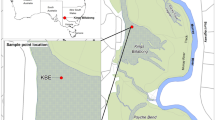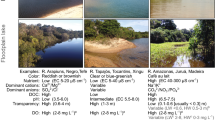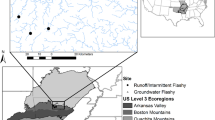Abstract
Contemporary river ecology is based primarily on biogeochemical studies of the river channel and interactions with shoreline vegetation, even though most rivers have extensive floodplain aquifers that are hydraulically connected to the channel. The hyporheic zone, the interstitial habitat penetrated by riverine animals, is characterized as being spatially limited to no more than a few metres, in most cases centimetres, away from the river channel1–9. However, riverine invertebrates were collected in hundreds per sample within a grid of shallow (10 m) wells located on the flood-plain up to 2 km from the channel of the Flathead River, Montana, USA. Preliminary mass transport calculations indicate that nutrients discharged from the hyporheic zone may be crucial to biotic productivity in the river channel. The strength and spatial magnitude of these interactions demonstrate an unexplored dimension in the ecology of gravel-bed rivers.
This is a preview of subscription content, access via your institution
Access options
Subscribe to this journal
Receive 51 print issues and online access
$199.00 per year
only $3.90 per issue
Buy this article
- Purchase on Springer Link
- Instant access to full article PDF
Prices may be subject to local taxes which are calculated during checkout
Similar content being viewed by others
References
Stanford, J. A. & Gaufin, A. R. Science 185, 700–702 (1974).
Schwoerbel, J. Arch. Hydrobiol. Suppl. 33, 1–62 (1967).
Husmann, S. Smithson. Contr. Zool 76, 161–169 (1971).
Williams, D. D. & Hynes, H. B. N. Freshwater Biol. 4, 233–256 (1974).
Danielopol, D. L. Int. J. Speleol. 8, 23–51 (1976).
Danielopol, D. L. Int. Rev. ges Hydrobiol. 65, 777–791 (1980).
Bretschko, G. Verh. int. Verein. Limnol. 22, 2049–2052 (1985).
Williams, D. D. in The Ecology of Aquatic Insects (eds Resh, V. H. & Rosenberg, D. M.) 430–455 (Praeger, New York, 1984).
Pennak, R. W. & Ward, J. V. Arch. Hydrobiol. Suppl. 74, 356–396 (1986).
Holsinger, J. R. Am. Scient. 74, 1467–153 (1988).
Ward, J. V. Trans. Am. microsc. Soc. 96, 452–466 (1977).
Holsinger, J. R. Crustaceana Suppl. 4, 244–281 (1977).
Ward, J. V. & Holsinger, J. R. Int. J. Speleol. 11, 63–70 (1981).
Pennak, R. W. & Ward, J. V. Trans. Am. microsc. Soc. 104, 209–222 (1985).
Hynes, H. B. N. Hydrobiologia 100, 93–99 (1983).
Ellis, B. K. & Stanford, J. A. Bioavailability of Phosphorus Fractions in Flathead Lake and its Tributary Waters (Open File Rpt. 81, Flathead Lake Biology Station, University of Montana, Polson, 1986).
Sediment Transport in Gravel Bed Rivers (eds Thorne, C. R., Bathhurst, J. C. & Hey, R. D.) (Wiley, Chichester, 1987).
Vannote, R. A., Minshall, G. W., Cummins, K. W., Sedell, J. R. & Cushing, C. E. Can. J. Fish, aquat. Sci. 37, 130–137 (1980).
Author information
Authors and Affiliations
Rights and permissions
About this article
Cite this article
Stanford, J., Ward, J. The hyporheic habitat of river ecosystems. Nature 335, 64–66 (1988). https://doi.org/10.1038/335064a0
Received:
Accepted:
Published:
Issue Date:
DOI: https://doi.org/10.1038/335064a0
This article is cited by
-
Physicochemical characteristics of lakes along the southern Baltic Sea coast
Scientific Data (2024)
-
Redescription of Utaperla orientalis (Plecoptera, Chroloperlidae) from Hokkaido: the first record of a Utaperla stonefly in Japan
Limnology (2024)
-
Inter- and intra-specific dietary overlap in predacious bi-phasic salamanders
Hydrobiologia (2023)
-
Population structure of obligate groundwater amphipod crustaceans (Stygobromus sp.) in alluvial aquifers
Hydrobiologia (2023)
-
A comparative study of integral and coupled approaches for modeling hydraulic exchange processes across a rippled streambed
GEM - International Journal on Geomathematics (2022)
Comments
By submitting a comment you agree to abide by our Terms and Community Guidelines. If you find something abusive or that does not comply with our terms or guidelines please flag it as inappropriate.



